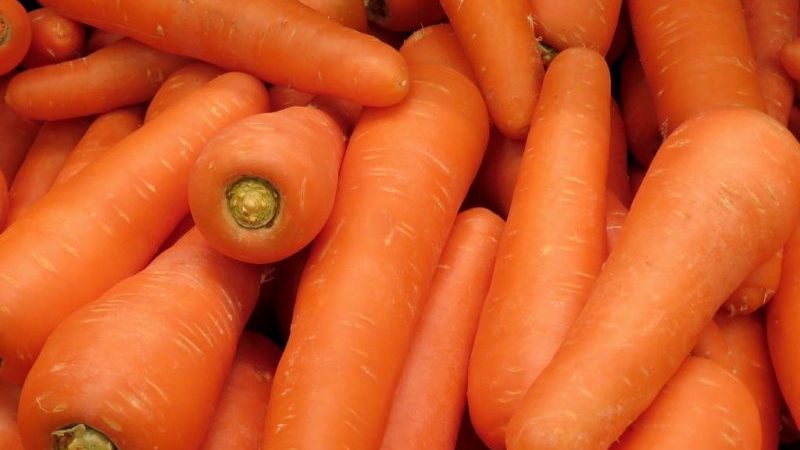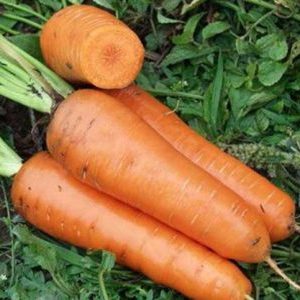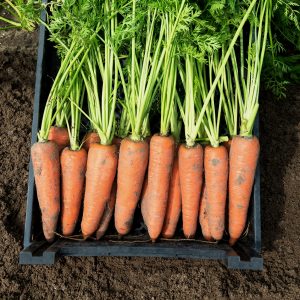Carrot hybrid for long-term storage Canada f1
Carrots are a popular garden crop in Russia. Summer residents especially appreciate medium-late and late high-yielding hybrids that can be stored for a long time. Carrot Canada F1 has just such qualities. In a short time, the new hybrid has earned the recognition of many vegetable growers due to its stable yield and reliability.
We will tell you what features the variety has, how to grow it and whether difficulties may arise in the growing process.
The content of the article
Description of hybrid carrot Canada
The culture belongs to the middle late, is distinguished by high yield and excellent keeping quality. Suitable for growing in difficult climatic conditions and heavy soils.
Pictured is a Canada F1 carrot.

Origin and development
Carrots Canada F1 - the result of the work of Dutch breeders from Bejo Zaden B.V. The hybrid was obtained by crossing Flakke and Chantane varieties.
Culture was included in the State Register of the Russian Federation in 2001. Today it is grown throughout Russia.
Chemical composition, trace elements and vitamins, useful properties
Canada F1 is a leader in nutrient content. The hybrid is rich in:
- Carotene in the amount of 21 mg. For comparison: the average values are 8-9 mg.
- Sugars - glucose, fructose and sucrose - 8.2-9.85%. However, their number depends on the composition of the soil and cultivation techniques.
- Iron, calcium, potassium, magnesium, sodium, chlorine, boron, sulfur and many other trace elements.
- Vitamins of group K, B (1, 2, 3, 5, 6, 9), E, C, A.
The combination of substances and vitamins has a beneficial effect on the human body:
- metabolic processes are normalized;
- the blood is purified;
- energy appears;
- vision improves;
- aging of the skin slows down, hair and nails are strengthened and healed;
- the work of the nervous system improves, headaches and insomnia stop.
Scientists have proven that the beta-carotene in boiled carrots is much better absorbed than in raw carrots.
Attention! Not recommended use root vegetables for people who are allergic to any components.
Ripening period
The hybrid belongs to the mid-late varieties. This means that 120-130 days should pass from germination to full ripening of the crop. Selective harvesting occurs in early July.
Yield
The hybrid is characterized by stable yields. A vegetable grower can collect from 3 to 7 kg of root crops from 1 sq. m. If the soil is light, the amount of yield increases.
Disease resistance
The culture has excellent immunity. It is resistant to flowering, Alternaria and Cercosporosis.
Characteristics and description of appearance
Distinctive features of carrots Canada F1:
- Bush. The ground part of the plant is a powerful semi-spreading rosette. Leaves are dark green, moderately dissected, moderately pubescent.
- Roots. They can be medium or long - 15-25 cm. They are slightly ribbed, cone-shaped and have a slightly pointed tip. The pulp is firm, without voids.The color is rich, dark orange. Weight varies between 95-110 g and 350-400 g.
- Taste qualities... Experts gave the hybrid 4 out of 5 points in tasting ratings. The heart is very juicy and sweet.
The mass of root crops depends on the quality of work on the preparation of seeds for sowing and subsequent care for the seedlings. The largest carrot was grown in Siberia, and it weighed 390 g.
Growing regions
The hybrid is actively grown throughout Russia. It is especially popular in the middle lane and Central regions. The variety is unpretentious to the climate. He is not afraid of frost, rains, as well as prolonged drought and scorching sun.
Advantages and disadvantages of a hybrid
By purchasing original seeds from the Bejo company, the gardener will see only advantages. This is due to the fact that the planting material undergoes special preparation with partial germination using the innovative B-MOX technology. It provides:
- guaranteed seed germination - seedlings develop quickly and amicably;
- there is no need to use special growth promoters;
- plant resistance to various diseases and adverse weather conditions;
- excellent taste and presentation.
The only drawback is the high cost of seeds.
Differences from others
Carrot Canada F1 is a unique hybrid with strong immunity. Reliability and guarantee of a rich harvest in any growing conditions are its main distinguishing features.
Features of planting and growing
Canada F1 shows good results on a variety of soils, even where other varieties cannot grow. The following tips and tricks will help budding growers plant and grow carrots properly.
Training
The creators of Canada F1 claim that planting material does not need preliminary preparation... However, hybrids do not always live up to expectations, and this one is no exception.
Experienced gardeners recommend soaking the seeds in warm clean water for 2-3 days. This will speed up germination. Additional procedures for the disinfection of planting material can be omitted. The hybrid has shown excellent immunity to all types of diseases.
Ground requirements
It should be recalled that the variety is undemanding to the soil. But the best yield is observed when growing carrots in clay and sandy soils with a low density. In this case, the soil should warm up to + 6 ° C.
Predecessors
The best predecessors in carrot beds are onions, tomatoes, and potatoes. After tomatoes and potatoes, it is better to carry out additional measures to disinfect the soil. Sometimes it can be inhabited by various viruses and fungi.
Timing, scheme and landing rules
Sowing dates are in mid-April or early May. The seeding pattern is as follows:
- Water the ridge, apply complex mineral fertilizers.
- Make grooves 1 cm deep.The distance between them should be 20 cm.
- Bury the seeds in each groove. The interval between plantings is 0.5 cm.
- After mulching with peat, cover with agrofibre.
Planting rules include compliance with the density - 90-100 seeds per 1 sq. m. It is important to avoid overly dense plantings, otherwise you can lose most of the crop.
Growing features
Growing Canada F1 carrots is easy. If the seeding rate has been observed, the gardener will be able to get rid of laborious planting care activities.
Seedling care includes watering, weeding, thinning, feeding, pest and disease control. But first things first.
Watering mode
Carrots do not require frequent watering. Excessive moisture leads to stagnation of water on the ridges and rapid decay of root crops. Watering frequency is 2-3 times a week in the evening.
Important! You can determine the need for water procedures by the top layer of the soil. If it hardens and dries quickly, it is recommended to increase the watering frequency. If the earth does not have time to dry out, this number should be reduced to a minimum.
Thinning and weed control
After 2-3 true leaves appear in the sprouts, the first thinning is required. At the same time, try to keep the distance between plants up to 2 cm. A repeated procedure is necessary after the appearance of 5-6 true leaves. Here the distance must be increased to 6 cm.
Attention! Thinning is the main event on the way to a rich harvest. If you ignore this point, the roots will stop developing (each plant will oppress the other).
Weed grass is the enemy of carrots. Root crops are poorly formed with a powerful accumulation of weeds in the bed. Therefore, it is important to weed in a timely manner, and throw the removed grass out of the site.
Top dressing
Carrots Canada F1 does not need feeding. If a vegetable grower wants to fertilize the planting, it is better to apply complex mineral fertilizers. In this case, the last top dressing should be performed 30 days before harvest.
Reference. Organic fertilizers in the form of manure or humus spoil the taste of root vegetables. They give them bitterness, make them look unattractive.
Disease and pest control
The culture can be damaged by carrot fly and bear. To get rid of insects, you should treat the areas with insecticides strictly according to the manufacturer's instructions. In this case, perform the last processing one month before harvesting.
Harvesting and storage
The process of collecting root crops implies following some recommendations and tips.
How and when to collect
The harvesting of the first fresh root crops begins at the end of July. For winter storage, carrots are harvested in mid or late September. The process involves manually extracting root crops from the ground. Then you need to let the carrots dry in the sun for 3 hours. Then remove the tops and send the crop for storage.
Storage features and keeping quality of the hybrid
Excellent keeping quality of the hybrid is its main advantage. Therefore, it is suitable for long-term storage. To prevent root crops from spoiling in temporary storage, it is important to take into account some of the nuances:
- Vegetables must not be washed.
- Better to store them in canvas bags. But each bag should contain no more than 5 kg of the crop.
- Can be stored in a sand box. Sort the vegetables, leaving only strong and beautiful ones.
- The room temperature should not exceed + 3 ° C.
If the recommendations are followed, the harvest will remain until next spring. Carrots are suitable for fresh consumption, conservation, all types of heat treatment.
Tips from experienced gardeners
Experienced farmers are advised to observe seeding rates, take into account predecessors, planting dates. It is also recommended not to rush into harvesting if it means subsequent long-term storage.
Harvesting too early has a negative effect on the keeping quality of root crops.
Read also:
Mid-season carrot variety Niiokh 336.
Reviews
The hybrid has been praised by farmers throughout the country. They note the rich taste of root crops and unpretentious care.
Eduard Plotnikov, St. Petersburg: «The Canada F1 carrot hybrid was seeded in the garden beds last year. I was pleased with a very decent harvest. The root vegetables were healthy, strong, juicy, and rich in flavor. I sent part of the harvest to storage - it lasted until next spring without any problems. A very good variety, I recommend it to everyone. "
Oleg Borozdin, Sverdlovsk: "I decided to purchase carrot seeds of several hybrids. Of all, I liked Canada F1. I didn't have any problems with growing. Taste and yield are the main reasons why I will recommend this hybrid to all beginners. I am very pleased with my purchase. "
Conclusion
Carrots Canada F1 is a novelty in the world of vegetables. Its main advantages are ease of cultivation, resistance to the main types of diseases, unpretentious care, excellent taste and a rich harvest.Root crops are large in size, juicy pulp, high in nutrients.
Every person can grow a hybrid on his site, regardless of the region of residence and personal experience. And the advice and recommendations of experienced gardeners will help turn the laborious process of growing into an interesting and exciting experience.